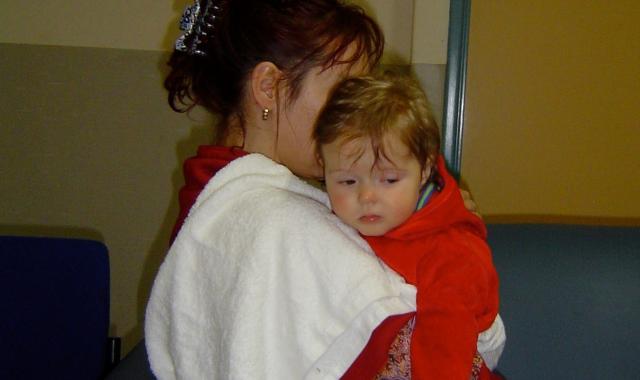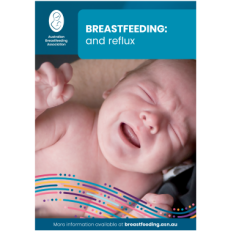Why your baby spits up milk and what you can do about it.

Some babies bring up milk between feeds. Apart from being messy, if your baby brings up milk, you may be worried whether there is something wrong.
How much is too much? Does my baby have reflux and should I be concerned?
This spilling of milk happens when some of the milk in your baby’s stomach passes up into their oesophagus (food pipe, the tube that leads from the mouth to the stomach) and spills out their mouth. This spilling can be called vomiting, spitting up, posseting or bringing up milk. Its official name is gastro-oesophageal reflux and it’s common and normal in babies, especially after a feed.
Why does it happen?
It happens because babies spend a lot of time lying down, have a liquid diet and a short oesophagus. As well, the muscle at the top of the stomach, which closes off the stomach from the oesophagus, is not yet strong in babies. Think of a drawstring on a bag that can’t be tightened yet.
Reflux is more likely to happen:
-
when your baby is lying down or when they are picked up quickly after lying down
-
when their stomach is very full
-
when there is pressure on their tummy from a tight nappy, clothing or a seat belt.
-
when a baby is in a slumped, curled or flat position, such as in some baby seats, car capsules, baby carriers or slings
-
during nappy changes or in the bath
-
in premature babies.
It doesn't seem to bother my baby
Many babies bring up some milk after a feed but aren't distressed. Although they may bring up milk several times a day, they put on weight well. This is called ‘simple reflux’. It usually stops by itself as your baby grows. Babies with simple reflux are sometimes called ‘happy chuckers’.
Reflux is equally common in both formula-fed and breastfed babies, but formula-fed babies have episodes of reflux more often than breastfed babies and they last longer.
What can I do to help?
Try out these ideas to see which work better for your baby.
Keep your baby more upright
-
Feed your baby in a position where they aren’t lying down, eg straddle hold or laid-back.
-
After feeds, keep your baby upright and still.
-
Hold your baby carefully on your shoulder after a feed.
-
If you need to burp your baby, do so very gently and keep baby straight rather than bent over.
-
Use an upright baby carrier instead of one where baby is curled up.
-
When changing your baby’s nappy, keep baby’s head higher than their body and roll baby's bottom sideways rather than lift it up.
Manage feeds
-
Your baby may do better with smaller feeds, more often. This puts less pressure on the muscle that closes off the top of their stomach, so milk is less likely to come back up.
-
Your baby may not want both breasts at each feed. They may vomit less if offered only one side but need feeding more often.
-
If you have a lot of milk, try giving your baby the same breast twice in a row when there is only a short gap between feeds. They can have the other breast a bit later.
-
Other mums find their babies prefer a larger feed less often because reflux episodes are worse in the first hour after feeds. These babies may prefer to feed from both breasts each feed and have a longer time between feeds.
Coping with the mess
Just because your baby is growing well and is a ‘happy chucker’ doesn’t mean that it is ‘just a laundry problem’. Healthy babies who vomit can be hard work, emotionally and physically. It can make it hard to leave the house because you may need a complete change of clothes midway through an outing.
-
Have small towels or cloths ready to put over your shoulder when you’re holding your baby (and offer them to others!).
-
Put large soft bibs over your baby’s clothes.
-
Prepare for more washing than usual. Have extra lines under cover, get an airer or a dryer.
-
Hold your baby carefully and keep them upright where possible. Choose calmer rather than active baby games.
-
When you go out, get everything ready first and change your clothes last thing before you leave.
-
Carry extras in a bag in your car: clothes for you and your baby, towels, wipes, a bag for the soiled clothing etc.
Although babies usually ‘grow out’ of both types of reflux, it can be a very difficult and tiring time for parents. Seek support and take care of yourself.
Common questions that parents ask
Baby vomit can look like it’s a lot when it spreads everywhere. You may be worried whether your baby is actually taking in their feed. It’s okay to offer baby another breastfeed to make up for this. Or you may notice that it’s better to leave some time before the next feed.
Check your baby’s nappy output if you’re not sure that they’re getting enough.
There is also ‘reflux disease’ (Gastroesophageal Reflux Disease or GORD) which is a medical problem and requires a diagnosis by your doctor and treatment.
With reflux disease, the acid in the baby’s stomach burns and causes damage to their oesophagus. This is fairly rare. Only a small number of babies have vomiting along with pain and crying.
Many babies get hiccups at times and it's usually nothing to worry about. They may happen more if your baby brings up milk often. But hiccups don't bother most babies, and will usually stop by themselves within a few minutes.
If your baby seems upset by their hiccups some of the above ideas may help.
© Australian Breastfeeding Association April 2022
Find out more about reflux
Evidence-led info and practical tips from our Special Situation Information Series
Breastfeeding: and reflux



